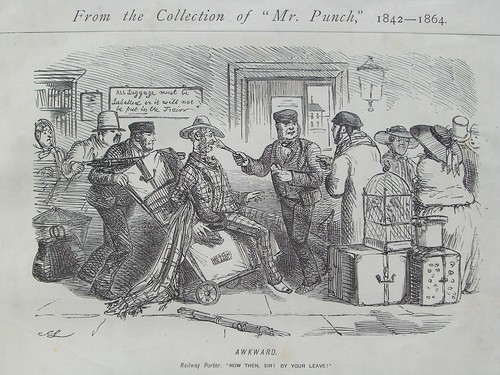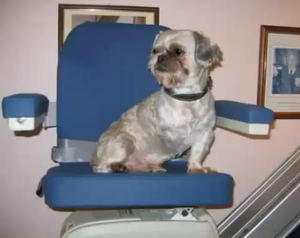 |
| Castle Comfort Stairlifts MD with Tracey Aherne of the Newcastle Bridge Club, receiving the silver- plated Castle Comfort Trophy. |
Bridging The Gap
Our latest local sponsorship award goes to Newcastle Bridge Club
With many members of local Bridge Clubs being customers of ours and reaching the ages when wanting a nice new recliner chair for their golden years is the norm, it made sense that we would like to be involved in the launch of an annual bridge competition at Newcastle Bridge Club. The winning pair will get their names engraved on "The Castle Comfort Cup" and also will win a cash prize, though it's not compulsory to spend it with us on any of our helpful products!
Scroll on down the page for more information all about Bridge as well as the club itself.
The Newcastle Bridge Club began nearly 65 years ago when a group from Basford Bridge Club set up their own matches in members homes and by hiring local meeting rooms. By the 1970's they were renting a second floor room on the High Street in Newcastle, but their need for ground floor premises of their own was answered in the mid 1990's when the building on King Street became available and after a lot of hard work from volunteers and some considerable loans from members and the bank, they took possession of the premises. The Club was officially opened by the Lady Mayor, Elsie Ashley, on Thursday 31st March 1994.
Of course, defining the word bridge goes well beyond the popular game about which we referring to with our sponsorship of Newcastle Bridge Club. Some years ago it entered the world of mobility products - to be exact stairlifts, when people with perhaps a limited a budget or simply cost conscious - needed a chairlift to go around a curve at the top of the stairs. A curved stairlift system until recent years ago could have cost between £4,000 and £7,000 - so certain manufacturers and specialist suppliers created a 'bridge platform' or often referred to as a 'bridging platform' This ingenious gadget constructed from a strong timber platform and small hydraulic hinges - enabled a straight lift to be fitted (a lot cheaper of course) and even with the extra £200 or so for the bridging platform - It was considerably less than the cost of a curved installation
Here it is, demonstrated by a 'supporter' of the Premier League team Stoke City, alias 'The Potters'
The disadvantage of a bridge platform however, is that apart from the fact it has to be lifted up and down manually by the user, they could fall of it and break their necks.
Hardly a mobility product acquisition linked to longevity!
Where the angle of the stairs and the width was considerable then the danger pointed out there is considerably less, but nevertheless, the industry has worked hard to avoid using a risky adaptation - and in recent years the cost of a good curved system, whether new or reconditioned has come down, and made them much more affordable.
Ironically, a stair-lift specialist near Stoke on Trent (whose directors are probably Stoke City fans - but not the one shown above) claim to be partially responsible for the dramatic reduction in the size of investment needed for less hazardous solutions to mounting a curved stair-well.
Castle Comfort Stairlifts, based precisely at Cross Heath and Wolstanton in Newcastle under Lyme claim, as agents for all UK manufacturers, to have enabled huge price drops due to the sheer volume of business generated by them.
Apart from handling their own direct contracts, the enquiries received are supplied to any one (OR MORE) of several manufacturers to compete for the work. These days, a price paid for a curved stairlift installation is more likely to be between £2,500 and £4,000 - still not tuppence halfpenny, but around half of what it was a few years ago. Few things we buy in life have followed such a price change pattern.
In essence, the public who contact Castle Comfort - find that they will probably receive a quotation (or more than one) to consider, that is a lot less than had they responded to a newspaper or a TV ad, thinking that was the only stairlift company to approach.
So apart from saving money, it is perhaps a better option than a broken neck! Call 01782 611411 or 01782 631111 for a free no obligation quotation for a curved (or straight) stairlift - or visit the Stairlift showhouse at Cross Heath for a ride on one!
BRIDGE THE GAME
"Every game has a character of its own appropriate to the company it keeps and the place where it is played."
David Partlett - Oxford Guide to Card Games
What do James Bond, Dwight Eisenhower, Warren Buffett, Bill Gates, Martina Navratilova, Omar Sharif and Snoopy have in common? They all play Bridge. Yes, Snoopy is no stranger to the bridge table, thanks to cartoonist Charles Schulz.
Bill Gates is a self-confessed bridge addict, attributing his condition to the billionaire investor and philanthropist Warren Buffett. Buffett, a die-hard player, once said "If I'm playing bridge and a naked woman walks by, I don't even see her"
James Bond, chalked up 7 redoubled in Ian Fleming's novel "Moonraker". The hand used by Fleming was an historic one. It is known as 'The Duke of Cumberland Hand.' Duke of Cumberland Hand - A purportedly rigged hand dealt to the son of George III, the King of England, resulting in the loss of a £20,000 wager. The hand was used in the James Bond movie, "Moonraker" against the villain Drax.
While Bond's 8 points don't look too strong, he uses Drax's tendency to clubs to promote his own diamonds resulting in a thundering thirteen tricks.
How old is Bridge?
An early reference to Bridge, using the earlier name of trump or English ruff can be found in a perhaps unlikely place, namely a sermon published in 1529 by Bishop Hugh Latimer . The sermon, entitled "On the Cards" was given on the Sunday before Christmas 1529 in St Edmunds Church, Cambridge. "And where you are wont to celebrate Christmass in playing at Cards, I intend, by God's Grace, to deal unto you Christ's Cards, wherein you will perceive Christ's Rule. The game that we play shall be called the Triumph, where, if it be well played at he that dealeth shall win, the players shall win and likewise the standers and lookers upon shall do the same. You must mark also that the Triumph must apply to fetch unto him all the other Cards, whatever suit they be of. What requireth Christ of a Christian man? Now turn up your Trump, your Heart, (Heart is the Trump as I said before) and cast your Trump, your heart on this card."
Bishop Latimer lived in very turbulent and dangerous times, the England of the 16th century. Monarchs and prelates were all powerful and religion was at the heart of much of the power struggle. It is sad to reflect that very little has changed. Today we see that the abuse of religion and ruthless fanaticism remains at the heart of much of the world's troubles. Those who were safe and in favour could very soon see the tide of fortune rapidly change. On his death, King Henry VIII left three heirs, his son Edward and two daughters, Mary and Elizabeth. On the death of Henry, Edward V1 ascended the throne in 1547. He was just nine years old. Henry was a Protestant or, in view of his young age, it may be more likely that his advisors were. During his reign the Latin services were translated into English and a desire to establish a more Bible based faith developed. Hugh Latimer, a Cambridge scholar and Bishop of Worcester, was favoured by Henry but failed to influence the King to allow the Protestant reforms. He had more success under Edward and, with two other men, Nicholas Ridley and Thomas Cranmer, the English reformation painfully took shape. On the death of Edward V1 at the age of fifteen, his cousin, Lady Jane Gray took his place but only for a mere nine days! Mary ascended the throne in 1553 and Mary was a Roman Catholic. She earned the name "Bloody Mary". Although fewer people were condemned compared with those at the behest of her father, Henry VIII, she had hundreds of people put to death, often by fire, solely because of their religious convictions. Mary had a firm objective and that was to return England to its 'true faith' , to Roman Catholicism under the Pope. Mary ordered that Latimer, Ridley and Cranmer be arrested. They had refused to recant on their Protestant beliefs and charged with heresy - punishable by death. Hugh Latimer and Nicholas Ridley were burnt at the stake outside Balliol College in Oxford on 16th October 1555. The same fate befell Thomas Cranmer on March 21st 1556. The clerics became known as the Oxford Martyrs. For all of his skills at the card table, Ridley failed to win his final game against a powerful player, Queen Mary 1st.They are commemorated close to the place of the executions by the Martyrs Memorial outside Balliol College, a landmark well known to Chief Inspector Morse!
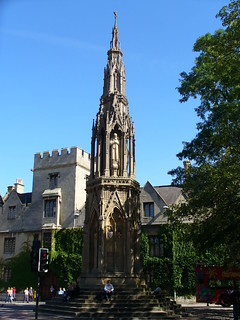 |
| Martyrs Memorial Oxford (Source: Flickr.com) |
Whist may have been a reference to the speed at which cards were swept up after a winning trick or perhaps a call for silence during play. It was in 1742 that the first book on the game was published, 'Short Treatise on Whist' by Edward Hoyles. The first game of Duplicate Whist was played in London in 1834.
Cards in Literature
Shakespeare uses card games quite frequently in his texts. An interesting reference is taken here from 'Antony and Cleopatra' It is probably a reference to a game called Trump. This was probably the triumfo of the Italians, and the triomphe of the French — being perhaps of equal antiquity in England with primero. At the latter end of the sixteenth century it was very common among the inferior classes. There is, no doubt, a particular allusion to this game in "Antony and Cleopatra" (iv. 14), where Antony says: "the queen — Whose heart I thought I had, for she had mine; Which, whilst it was mine, had annex'd unto't A million more, now lost — she, Eros, has Pack'd cards with Caesar, and false-play'd my glory Unto an enemy's triumph." There is confusion between trump and triumph. The game in question bore a very strong resemblance to our modern whist — the only points of dissimilarity being that more or less than four persons might play at trump; that all the cards were not dealt out; and that the dealer had the privilege of discarding some, and taking others in from the stock. In Eliot's "Fruits for the French," 1593, it is called "a very common ale-house game in England." Players of modern day bridge may not be too pleased by such a description!
Charles Dickens (1812-1870)
Charles Dickens was arguably the first English novelist to write with a social conscience. The gap between rich and poor, the legal system, the exploitation of children and conditions in the workhouse and prostitution all came under his scrutiny. Dickens viewed card games as a symbol of class and social mobility as well as a potential evil.
In Victorian days, cards were associated with gambling and as such were often frowned upon. 'Great Expectations', thought by Dickens to be his finest work, appeared in weekly instalments in the periodical 'All the Year Round' between December 1860 and August 1861. Young Pip is summoned by Miss Haversham to Satis House and commanded to wait upon her once a week. On first meeting, the mad Miss Haversham, still attired in her now shabby wedding gown, commands the boy to "Play, play play!"
Pip is overwhelmed but agrees to play cards with the adopted daughter Estella, who remonstrates "Play with this boy! Why, he is a common labouring boy!" "What do you play, boy?" asked Estella of myself, with the greatest of disdain. "Nothing but Beggar-my-neighbour, miss."(Beggar-my-neighbour first appears in the Oxford Dictionary in 1734 but may have evolved from an earlier game Knave Out of Doors from as far back at the 16thcentury.) "Beggar him," said Miss Haversham to Estella. So we sat down to cards. Estella beats Pip at every game and uses her skill to dominate and belittle him. As Pip grows up and becomes a gentleman he makes acquaintances in the higher echelons of society. What he had assumed would bring him happiness and fulfilment failed to come up to his expectations. Only when he rejects games playing and other trappings of the gentility does he find contentment. Pip accepts the values of the Victorian middle classes, loyalty, honesty and hard work which trumped the games of trickery and chance played by other characters in the novel.
Agatha Christie (1890-1936)
Even the least amongst lovers of literature will almost certainly have heard of the crime writer Agatha Christie. One of her best known characters, featured in the TV series, is the fictional Belgian detective, Hercule Poirot. Bridge is featured in the 1936 novel 'Cards on The Table.' There are four key players, Superintendent Battle, Colonel Race, Ariadne Oliver and Hercule Poirot. Whilst not usual police procedure, the Superintendent in charge of a murder investigation, agrees to work with three other 'sleuths', sharing all of the facts equally. "Cards on the table, that's the motto for this business" . The plot is that all of the potential murders played bridge together at the time of the murder. Poirot 's technique is to study how each of the suspects played bridge; their skill level, risk taking and their killer instinct. By using the way they played he could gain insight into their psychology and thus be led to the killer.
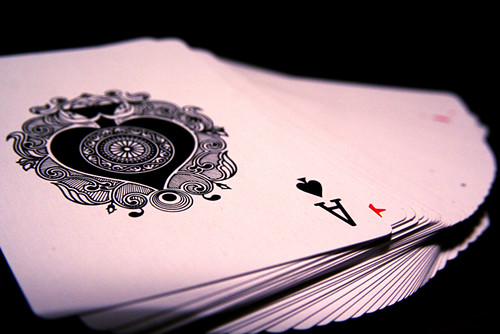 |
| Source:Flickr.com-stevendepolo |
Bridge Players
Since the average person's small supply of politeness must last him all his life he cannot afford to waste it on bridge partners. (Alfred Sheinwold)
Bridge players are found all around the world and from all walks of life. From Monarchs and Presidents, film stars, academics, and politicians, to the ordinary man in the street, bridge has a compelling appeal. Each year teams from both The House of Commons and The House of Lords compete at the bridge table. Bridge is played at local club level and at national and inter-national level where both the determination to win is only matched by the high stakes.
The Cavendish Invitational
One of the largest, if not the largest event, certainly in terms money, is The Cavendish Invitational. The Cavendish Club, whose name is associated with the event was founded in New York back in 1925. Among the members were some of the greatest names in bridge. For whatever reasons, it moved around from Mayfair House, the Ambassador Hotel to the Ritz Tower Hotel and Carlton House. The club began hosting the Cavendish Invitational Pairs in 1975. The event continued for a number of years but in 1991, financial difficulties and a dwindling membership, forced the New York club to close its doors. However, the event continued in New York until 1997 when a major boost to its future occurred. World Bridge Productions took over the Invitational Pairs tournament and moved to the glitzy environment of Las Vegas. This was not only to raise the profile of the event but also the purse. More players were needed and WPB introduced another tournament, the Open Pairs. This is an auctioned event and is surrounded by drama and wealth. The day before the event, a black tie cocktail party is held where all the top pairs are acquired by the highest bidders. The pool can be in the region of $1million or more. The pairs purchase a minimum share of 10% in themselves and may go as high as 40% or more if agreed with the winner of the bid. So, what happens to the pool pot? At the end of the tournament, 95% is shared out proportionally. The rules are that each pair plays three boards against each of the other pairs, with a time limit of twenty five minutes per round with a total of forty five rounds being played to decide the winner. In 2012, the tournament moved location to Monaco.
Monaco 2014 gave some unexpected results as the choices made by the auctions turned out to not always be the correct ones. Number 1 rated Helgemo Helness had to be satisfied with second place in Final B which was won by the Russian pair, Gromov/Dubinin. Last year's winners, Nanev/Gunev, didn't qualify for Final A and only managed to claim eighth place in Final B. The final winners of 2014 Open Pairs, with a commanding superiority were Polish pair Krystof Buras and Gregorz Narkiewicz.
Buffett Cup
Another prestigious bridge tournament is the Buffett Cup, named of course after Warren Buffett (the inspiration behind Bill Gates' addiction to bridge) first staged in 2006. The event is modelled on the Ryder Cup golf competition with teams competing from the USA and Europe. This biennial event is held the week preceding the Ryder Cup. Teams are selected by invitation and must include at least two female players. The tournament allows for a mixture of teams of four, pairs and individual sessions. The 2014 Buffett Cup was scheduled to be held in Monaco but in the event it never happened. It was Europe's turn to offer a location and Monaco graciously offered to be the host and provide funding, with the exception of airfare. The problem was that the American Bridge Federation agreed to fund the tickets but then withdrew the offer. It seems that agreement could not be reached when deciding on the US team and months of bitter infighting followed, resulting in cancellation.
Bridge over troubled water
I now return to Agatha Christie's 'Cards on The Table' and the theme of murder. Surely, there is no connection between murder and bridge? Well, in fact there is more than one recorded murder where bridge was a factor.
"Regardless of what sadistic impulses were may harbour, winning bridge means helping a partner avoid mistakes." (Frank Stewart)
The Bridge Murder Case September 1929
What activities should a married couple never undertake together? No doubt there are many. I would certainly list learning to drive and hanging wallpaper! It would seem that playing bridge should be added to the list. It has led to murder - literally.
It all started as a perfectly normal social occasion between neighbours on the evening of September 29th 1927 in Kansas City. John and Myrtle Bennett were hosts to their friends Charles and Myrna Hofman who lived in the same affluent apartment block. Earlier in the day, the two men had played golf. John Bennett was said to be of a volatile disposition and was prone to slapping his wife when things failed to go his way - not an ideal qualification for bridge partners! The Hofmans were not skilled players and the Bennetts were soon in a commanding lead.
As the evening progressed the Hofmans managed to catch up and then took the lead. The tables had been turned by the time the fatal hand was played. In the debacle that followed, the cards were scattered and the exact nature of the hand is largely a guess. What was remembered by the survivors was the bidding.
John Bennett opened one spade, Charles Hofman overcalled two diamonds and Myrtle Bennett ended the auction with a jump to game in spades. After Mr Hofman made the opening lead Mrs Bennett spread as dummy a collection of cards Myrna Hofman was later to describe as "a rather good hand". Myrtle clearly believed the dummy she had laid out added to the values of her husband's first bid and should easily have resulted in game but Mr Bennett managed to fail in his contract by two tricks. It was then discovered that he had opened on less than full values.
It was alleged that after Mr Bennett played the hand to its inevitable less than glorious conclusion, his wife added to the already volatile atmosphere by calling him "a bum bridge player."
What followed is taken from Myra Hofman's testimony. The Hofman's tried to restore calm but could not do so. Bennett slapped his wife several times and said that he was going to spend the night in a hotel and then leave town.
What followed bears an uncanny likeness to the events described in the recent trial of Oscar Pistorius! John Bennett went to the bedroom and started to pack a suitcase and Myrtle went to her mother's room where she knew there was a loaded gun. Seeing the gun, John Bennett ran into the bathroom and bolted the door. Myrtle fired twice through the locked door. Unlike the Pistorius case, both shots missed.
A frantic John Bennett escaped from the bathroom by another door which led into a hallway, ran through the lounge and made an unsuccessful attempt to open the front door. Myrtle was quickly upon him and fired another two shots, this time with fatal results. Myrtle Bennett was charged with first degree murder. In the trial that followed Myrtle pleaded not guilty and claimed that she brought the gun to give to her husband as he routinely carried one when going away on business trips. The gun went off by accident as she tripped up in hall. Incredibly the jury chose to ignore the two bullet holes in the bathroom door and the fact that there was no suitcase in the hall. Mrs Bennett was acquitted. (Source:Wikipedia.org)
So, the Bennett case was a long time ago and surely such a case couldn't happen again. Well, it did as recently as July 2010. The shocking case was reported by 'BBC News Lancashire.'
Bridge player Stephen Green guilty of wife's murder
A former world championship bridge player has been jailed for life for murdering his wife in a knife attack. Stephen Green, 52, stabbed Carole Green, 57, 100 times at their flat in Lytham St Annes, Lancashire. A jury at Preston Crown Court took 75 minutes to convict the former British Aerospace worker after a week-long trial. The murder followed his constant criticism of her card-playing. He was ordered to serve a minimum of 23 years after being found guilty of her murder. The court was told of the couple's stormy relationship, Green's heavy drinking and constant bickering about Mrs Green's playing abilities at Lytham Bridge Club, where they first met. The court heard testimonies from fellow bridge players who said that Green considered his wife to be a mere "club player" and viciously put her down in front of friends. It beggars belief that a card game could be taken so seriously as to result in an extraordinary motive for a frenzied attack by a player of world championship status.
What is the future for Bridge Clubs? We are living in a high tech world. Every electronic gadget has to be fast, exciting and gratification has to be immediate. Viewers of 'Click' will know that the industry brings out something new to tempt our obsession with all things cyber and virtual with frightening regularity. One can of course play bridge on line but this is another example of people interacting with others, who may or may not be real, in a solitary environment, an introverted world - we are losing the ability to socialise. A part of going to play real bridge with real people in a real place should not be surrendered easily. However, I fear that such activity may be the domain of a dwindling number of predominately older people, unless the image of the game or some of the discipline required to learn it changes somewhat.
Writing in 'The Independent' (Monday October 27th. 2014), Maureen Hiron, The Independent's bridge correspondent, expressed fears for the future of what may be claimed to be the world's most sophisticated and subtle card game. She believes it to be both an image problem and too complicated, especially for younger people. "The world's most sophisticated and subtle card game has got a serious image problem. While poker conjures up notions of fast cars, loose women and all-nighters in Vegas, bridge is more likely to suggest cucumber sandwiches, blue rinses and afternoon naps.
That's why Ms. Hiron, The Independent's in-house expert, set out to create a faster, funkier version that would bring younger players flocking to the green baize." I can hear the purists shouting with outrage already! "Two years ago, Maureen Hiron -The Independent's bridge correspondent - was playing a weeknight club game with her expat friends in Marbella when there was a break in play. Table seven had been asked to speed up a little. The instruction, quite literally, fell on deaf ears. That night, table seven consisted of a 98-year-old golfing Canadian called Sidney Matthews; Edith Gross, 95, a former ballerina who once danced for Adolf Hitler; Lilian Matthews, a Spanish international bridge player, 90; and 90-year-old Lorenzo Runeberg, a Finnish international known as "Ruthless Runie". They had a combined age of 373.
For Hiron, a British international herself, there couldn't have been a clearer example of the way bridge is becoming a dangerously old game. She is not the only one to make this observation. Ever since poker took off in Britain in the last decade, bridge has been fighting an uphill battle. Although, worldwide, 200 million people play bridge, it is an increasingly ageing constituency. And in Britain, despite signs in the Nineties that the game was bursting with life, there are now fewer than 30,000 members of the English Bridge Union, the game's governing body. The average age of EBU members is 55 (for the American Contract Bridge League that figure is over 60).
As a solution towards this she has created a game called Abridged, a simplified version of bridge. It gets rid of bidding, the most complicated part of the game and uses colours, not suits. Face cards have been replaced by the numbers 11,12,13 and 14. Abridged is a huge hit in America. After an initial sell out run, another 50,000 boards are about to hit the shops. Can it be the same here in Britain?
"I can see what is happening in bridge," says Hiron. "Because it's become so complex, because the learning curve has become so huge, people are put off by it. It's only natural. Bridge is a living, breathing game, and it has developed. That's fine for committed players but it means that to learn the game can be eternal for some people. What I have done is to get rid of the complicated part of the game, so people can start playing in twenty minutes. "
Chair of the English Bridge Union Peter Stoken had this to say about it. "There's absolutely no reason why the average age of bridge players should be going up. It's entirely our own fault for not coming to grips earlier with what we should be doing. We've come to realise that bridge needs a change of culture, and what we need to do is to create happy, friendly clubs where you can get a good game. One of the blights of bridge in the past, for instance, has been the bad behaviour of some. God knows, I was guilty of it in my youth. It's usually partners getting at each other, and it's incredibly off-putting."
Do you play bridge? Did it take you a long time to learn the intricacies of the game? What age did you start learning it? Let us know in the comments, and if you do fancy a few games or want to start learning then call the club on 01782 611164 to find out more about it.





.JPG)











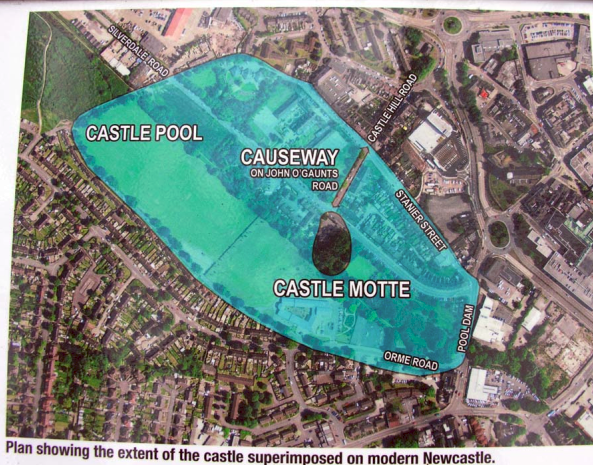












.JPG)
.JPG)
